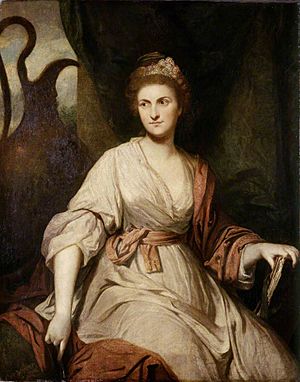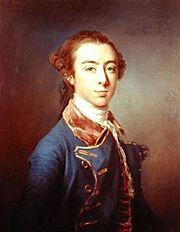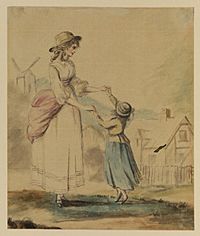Lady Diana Beauclerk facts for kids

Lady Diana Beauclerk (born Lady Diana Spencer; 24 March 1734 – 1 August 1808) was an English noblewoman. She was also a celebrated artist known for her paintings and designs.
Contents
Early Life and Art
Lady Diana was born into the important Spencer family. Her father was Charles Spencer, 3rd Duke of Marlborough. Her mother was Elizabeth Trevor. She grew up at Langley Park, Buckinghamshire.
From a young age, Lady Diana was introduced to art. A famous painter, Sir Joshua Reynolds, was a friend of her family. This early exposure helped her develop her artistic talents.
Marriages and Family
On 8 September 1757, Lady Diana married Frederick St John, 2nd Viscount Bolingbroke. She had four children with him. From 1762 to 1768, she worked for Queen Charlotte. During this time, she became known as 'Lady Di'.
Her first marriage was difficult. It later ended, and she married Topham Beauclerk. They had three children together.
Her children from her first marriage were:
- George St John, 3rd Viscount Bolingbroke (born 1761)
- Henriette St John (born 1762)
- Anne (born around 1764)
- General Frederick St John (born 1765)
Her children from her second marriage were:
- Elisabeth Beauclerk (born 1766)
- (Anne) Mary Day Beauclerk (born 1766)
- Charles George Beauclerk (born 1774)
Friends and Social Circle
Lady Diana and her second husband had many famous friends. Their group included important figures like Samuel Johnson and Edward Gibbon. They also knew David Garrick, a famous actor.
Another close friend was Georgiana Cavendish, Duchess of Devonshire. Georgiana was known for hosting popular social gatherings.
Artistic Work and Career
Lady Diana used her artistic skills to support herself. She painted portraits of people. She also created illustrations for plays and books. She even designed patterns for Wedgwood pottery.
Her friend Horace Walpole greatly admired her work. He wrote letters that tell us a lot about her life. Lady Diana became a respected artist. This was impressive because it was hard for women to have careers back then.
Designs for Sculpture
Lady Diana also designed a special sculpture. It was made by the Coade Stone factory. This sculpture decorated a building at Lombard Street, London. The sculpture was saved before the building was torn down. Today, you can see it at the Horniman Museum.
Later Life and Legacy
Lady Diana's second husband passed away in 1780. After this, she lived a quieter life. She died in 1808 and was buried in Richmond, Surrey.
Lady Diana Beauclerk is remembered as a talented artist. She showed that women could succeed in the art world.
Images for kids
-
Part of a stipple engraving of her friend and cousin Georgiana Cavendish.




